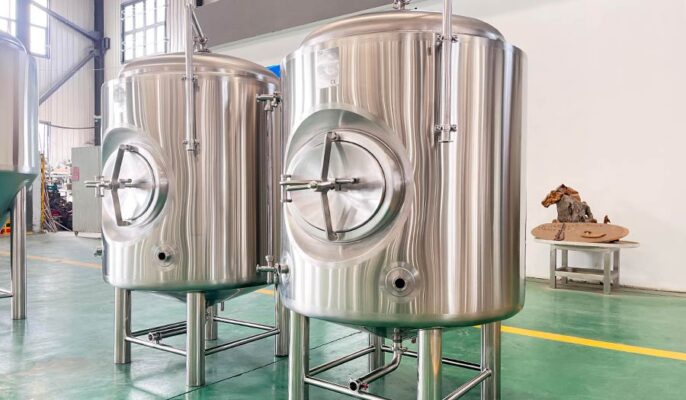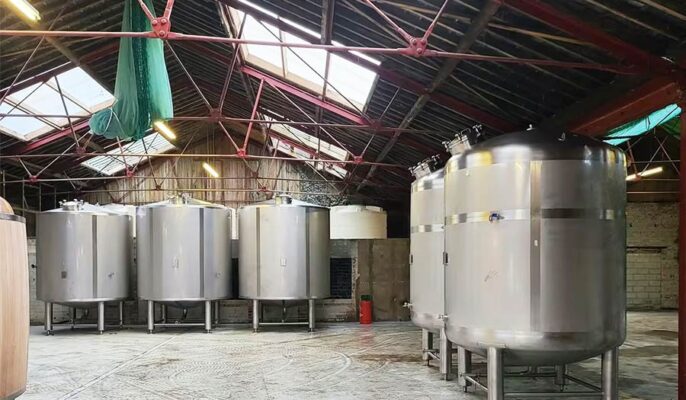스테인리스 스틸 탱크 play a vital role in beer brewing and other industrial applications. Their corrosion resistance and durability make them ideal for storing and handling a variety of liquids. However, even the highest quality stainless steel requires regular cleaning and maintenance to ensure its performance and sanitation standards. Cleaning stainless steel tanks not only prevents the accumulation of contamination and residue but also extends the life of the tank and ensures the quality of the end product. In this article, we will show you how to clean stainless steel tanks safely and effectively.
무엇인가요? stainless steel water tank and what is its role?
A stainless steel water tank is a container made of stainless steel used to store and process water, beverages, chemicals, and industrial liquids. Stainless steel is widely used in various fields due to its excellent corrosion resistance, wear resistance, and high-temperature resistance.
Features of stainless steel water tanks:
- Corrosion resistance: The main advantage of stainless steel is its excellent corrosion resistance, which can resist the erosion of moisture, in acidic and alkaline environments.
- Strength and durability: Stainless steel has good mechanical strength and can withstand high pressure and mechanical shock, extending its service life.
- Hygiene: The surface of stainless steel is smooth and easy to clean, which can effectively avoid bacterial growth and contamination, and is very suitable for the food and beverage industry.
- Beauty: The surface of stainless steel is modern and beautiful, often used in places that require a neat appearance.
The role of stainless steel water tanks
Stainless steel water tanks have become an ideal choice for liquid storage and processing in many industries due to their superior durability, hygiene, and corrosion resistance. Through proper maintenance and cleaning, its performance can be ensured to be stable for a long time to meet various application requirements.
- Beer Brewing and Beverage Production: In breweries and beverage production, stainless steel tanks are used to store raw materials (such as water and malt), liquids during the fermentation process, and the final product. These tanks can maintain the freshness of liquids and prevent external contamination.
- Industrial Applications: In industrial production, stainless steel tanks are used to store chemicals, pharmaceuticals, and other liquid raw materials. Their corrosion resistance ensures that chemicals will not react to the container or cause leakage.
- Construction and Water Treatment: In construction sites and water treatment facilities, stainless steel tanks are used to store and distribute clean or treated water. Their sturdy structure can withstand large-capacity liquid storage needs.
- Agriculture and Breeding: In agriculture and breeding, stainless steel tanks are used to store drinking water and other liquid supplies to ensure the health of animals and the smooth progress of the production process.

Why should stainless steel water tanks be cleaned?
To maintain the hygiene of water, water tanks must be cleaned. The following substances may accumulate in the water tank over time:
- Dirt
- Dust
- Debris
- 곰팡이
- Dangerous bacteria
오염 방지
Stainless steel water tanks are used to store and process various liquids, such as water, beverages, chemicals, or industrial raw materials. If they are not cleaned for a long time, bacteria, mold, algae, and other microorganisms may accumulate in the water tank. These contaminants not only affect the quality of the stored liquid but may also cause health risks or production problems.
Maintain liquid quality
During beer brewing, beverage production, or other food processing, the sanitation of stainless steel water tanks directly affects the quality of the final product. Residues, sediments, or microbial contamination may change the taste, smell, or appearance of the liquid and reduce product quality. Regular cleaning ensures that the liquid remains fresh and meets quality standards.
Prevent sediment accumulation
Stainless steel water tanks may accumulate minerals, sediments, and other residues during use. If not removed in time, these sediments may cause the water tank to clog, reduce flow, and even affect the normal operation of the equipment.
Improve equipment life
Regular cleaning not only prevents contamination and sediment but also maintains the structure and function of stainless steel water tanks. Long-term accumulation of dirt and corrosion may cause damage to the water tank material, thus shortening its service life. Proper cleaning and maintenance can extend the service life of the water tank and reduce the frequency of repair and replacement.
Ensure compliance
In many industries, especially in the food and beverage production industry, there are strict regulations and standards for the hygiene and cleanliness of equipment. Regular cleaning of stainless steel water tanks can ensure compliance with relevant regulations and industry standards, and avoid legal and safety issues caused by hygiene issues.
Optimize performance
A clean water tank can maintain optimal performance. Sediment and dirt can affect the heat exchange efficiency, liquid storage capacity, and overall operating efficiency of the water tank. By keeping the water tank clean, it can ensure that it can operate normally under various working conditions and achieve the best results.
Improve operational safety
The accumulation of dirt and sediment may not only cause equipment failure but also cause safety hazards during operation. For example, a corroded or damaged water tank may leak, causing danger or environmental pollution. Regular cleaning can reduce these risks and ensure the safety of the operation process.

Advantages of Stainless Steel Tanks
내구성
Stainless steels are more corrosion-resistant than regular carbon steels in a variety of applications. They last longer due to their high durability and corrosion resistance. Stainless steel is essential to ensure that the quality of the items you keep is not affected. If you place the tank outdoors, stainless steel can also help you eliminate weathering issues that may occur when using steel or plastic.
Environmental
The impact of mining and the materials used in production on the environment is a key consideration when deciding which storage tank to buy. Steel is the most recyclable material in the world. New stainless steel can be recycled 60% to 70% without any loss of quality, and its carbon impact is minimized because little energy is required to produce it. In addition to being a safe metal alloy, stainless steel will not deteriorate or release pollutants into the environment.
손쉬운 청소
Stainless steel has a smooth surface, is not easy to adhere to dirt, and is easy to clean and disinfect. This makes stainless steel tanks particularly suitable for the food and beverage industry, which can effectively avoid bacterial growth and cross-contamination, ensuring the hygienic safety of products.
고온 내성
Stainless steel can withstand high-temperature environments and is not easily deformed or damaged by temperature changes. This makes stainless steel tanks suitable for applications that require high-temperature handling, such as hot water storage, food processing, and chemical reactions.
How to clean a stainless steel water tank?
Pretreatment and preparation
Before you start cleaning, first make sure the water tank is empty and perform a preliminary rinse with a high-pressure water gun. This step removes visible dirt and residual liquid in the water tank and prepares it for subsequent cleaning. Prepare the necessary tools and cleaning agents, including brushes, sponges, soft cloths, and high-pressure water guns, as well as suitable cleaning agents such as alkaline cleaners or acidic cleaners.
Selecting cleaning agents
Choose the appropriate cleaning agent according to the type of residue in the water tank. Alkaline cleaners are suitable for removing grease and organic matter, while acidic cleaners are effective in removing mineral deposits and scale. For breweries, using special brewery cleaning agents can more specifically deal with hops and yeast residues.
청소 단계
- Preliminary rinse: Use a high-pressure water gun to thoroughly rinse the inside of the water tank to remove most of the visible dirt. This can help the cleaning agent work better.
- Apply cleaning agent: Add an appropriate amount of cleaning agent to the water tank and apply it evenly with a brush or sponge. Make sure the cleaning agent covers the inner wall and bottom of the water tank and treats hard-to-reach areas.
- Soak and scrub: Let the detergent soak in the water tank for some time (usually 30 minutes to 1 hour) to break down the dirt. Then, use a brush or sponge to scrub the inner wall, especially in areas where dirt has accumulated.
- Thoroughly rinse: Rinse the inside of the water tank thoroughly with plenty of clean water to ensure that the detergent is completely removed. This step can be repeated several times until the water runs clear and there is no foam.
- Check and dry: Check whether the inside of the water tank is clean. Rinse again if necessary. After cleaning, wipe the inside of the water tank with a clean cloth and make sure the water tank is completely dry before using it.
Maintenance and inspection
Regular cleaning of the water tank is the key to maintaining its good condition. Make a regular cleaning plan and record the date, cleaning agent, and method of each cleaning. In addition, regularly check the condition of the water tank, especially the welds and seams, to ensure that there is no corrosion or damage. If any problems are found, repair them in time.
자주 묻는 질문
Why do stainless steel tanks have dirt and deposits?
Stainless steel tanks may develop dirt and deposits during use due to minerals, grease, chemicals, or microbial residues in the liquid. Especially when storing liquids for a long time or under high-temperature conditions, the accumulation of deposits and dirt is more common. Therefore, regular cleaning is essential to prevent these problems from affecting the use of the tank and the quality of the liquid.
How to clean the outside of a stainless steel tank?
Simple soap, mild detergent, or ammonia in warm water applied with a soft cloth or nylon sponge is the best choice for cleaning stainless steel. In rare cases, the softest nylon scouring pad may be required. After rinsing, wipe dry with a soft cloth.
How to choose a suitable detergent?
The choice of detergent should be based on the nature of the liquid residue. Alkaline detergents are suitable for removing grease and organic matter, and acidic detergents are suitable for removing mineral deposits and scales. For specific industries such as beer brewing, it is more effective to use specialized detergents. Be sure to follow the product instructions and choose a detergent that is compatible with stainless steel.
Is it necessary to disinfect after cleaning the stainless steel tank?
In some industries, especially the food and beverage industry, disinfection after cleaning is necessary. Disinfection can further remove any potential microbial residues and ensure the hygiene of the tank. Use a suitable disinfectant and follow the product instructions to ensure thorough disinfection.




